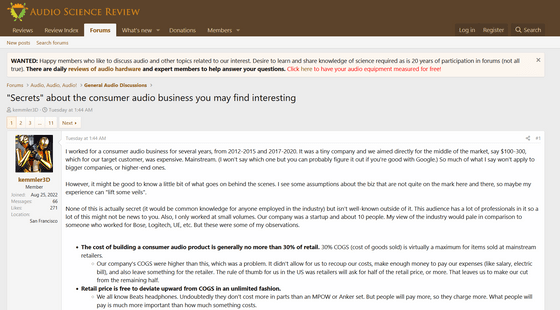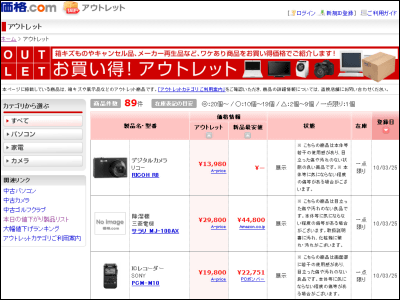People in the audio industry reveal secrets such as 'the cost rate is less than 30%' and 'there are almost no brands with their own factories'

Audio equipment has a simple purpose of producing sound and music, but there are a wide variety of products, from those sold at a surprisingly cheap price to those with an eye-popping price. An Internet user who has several years of experience working for an audio company is making headlines by posting industry insider stories on audio equipment review forums.
'Secrets' about the consumer audio business you may find interesting | Audio Science Review (ASR) Forum

On September 13, 2022, a user named
According to kemmler3D's self-introduction, he worked for a consumer audio equipment company from 2012 to 2015 and from 2017 to 2020. The company is a small startup with about 10 employees, and it seems that it was working on mainstream mid-price products as audio equipment of 100 to 300 dollars (about 14,000 yen to about 43,000 yen).
Having worked at a small company, he said, 'It wouldn't apply to large companies or high-end equipment companies.' It may help lift the veil.” Here are 10 things you should know about the audio industry.
◆ 01: The manufacturing cost of consumer audio products is generally less than 30% of the retail price
According to kemmler3D, the cost of goods sold at major retailers is effectively capped at 30%. In the United States, the retailer's cut is typically more than half of the retail price, so the audio companies recover the cost from the other half and then pay their own salaries, electricity bills, and other overhead costs. Because it is indispensable.
Also, kemmler3D said that it is not unfair unless the cost is less than 10% of the selling price, based on personal feeling. This is because companies have a number of costs associated with selling their products, from employee health insurance to regulatory compliance around the world.

◆ 02: Retail price can be infinitely added to the cost price
The upper limit of the cost rate for audio equipment is 30%, but it is said that there is no lower limit. An example of this is Beats headphones. According to kemmler3D, Beats headphones never cost more than MPOW or Anker. 'Still people pay more money, so companies charge more money. How much people pay is more important than how much it costs,' commented kemmler3D.
◆ 03: Marketing costs have little to do with cost rate and quality
Products that are expensive but perform poorly are often criticized for spending too much money on marketing and neglecting research and development. However, this is only true for some big brands, and for most brands whose sales do not exceed $ 100 million (about 14.3 billion yen), marketing costs are not too high.
In this regard, kemmler3D said, ``Familiarity alone is not very commercial.Unless you can beat Sony or Apple for more than two years, you should forget that strategy.''

04: Few audio brands operate their own factories
According to kemmler3D, there are almost no audio makers that manufacture all parts in-house, including famous large companies, and most of them outsource to overseas factories. However, audio equipment requires various parts such as drivers, cables, and housings, and it is difficult and inefficient to produce them alone, so kemmler3D says this is not a bad thing. .
◆ 05: Most Chinese factories and engineers can make higher-end products
There is a strong image among consumers that Chinese products are cheap, but many Chinese manufacturers can make high-performance products. The reason why this is not the case is that considering the cost of switching production lines for each product, it is more profitable to mass-produce products that sell well at lower prices than to produce a small number of high-quality products that may or may not sell. .
Kemmler3D said that he felt sad when he saw a man bluntly say to a female staff member at a booth where Hi-Fi-like items were placed, 'Show me something cheap, big, and noisy.' Based on his experience in Hong Kong, he commented, 'In fact, consumers have a perception that audio from certain countries is of low quality.'
◆ 06: Scale merit is certainly important
According to kemmler3D, factories that produce in small lots are more likely to have quality control problems and tend to be more expensive.

◆ 07: Audio manufacturers do not have as advanced technology as consumers think
Companies that design and manufacture audio equipment have very sophisticated technology. Contrary to the image of consumers, it does not have technical strength.
Kemmler3D says, 'Skills such as product development and management are important jobs for audio companies, but you don't need audio expertise to do such work. So, if you say, 'Is it properly inspected in-house before shipping?' If you ask yourself, the answer may actually be 'no'.'
◆ 08: Shipping fee is high
Kemmler3D noted that this should not surprise anyone, but emphasized that logistics costs can be prohibitive, especially for audio equipment such as speakers with heavy and bulky parts such as housings and magnets.
◆ 09: Packaging cost is also important
Some mid-range in -ear monitors (IEMs) cost more in the packaging than in the contents. ``On Amazon, IEMs procured for $2 are sometimes sold in a $3 box for $20, but strangely everyone seems happy,'' commented kemmler3D.

◆ 10: Major retailers can neither stick to sound quality nor sell state-of-the-art products
According to kemmler3D, major retailers such as Target, Best Buy, and Walmart are not equipped to handle ultra-high-quality products that audiophiles demand. Of course, it's not that the buyers at these companies are incompetent or deaf, but their job is not to sell top-of-the-line products, but to make the best use of the sales space allotted for audio equipment. . Therefore, audio equipment from well-established brands that are known to sell well are often chosen, rather than expensive SOTA products that may or may not sell.
Therefore, kemmler3D says, ``If a product that sells happens to make a good sound, the retailer will purchase it, and if there are multiple products that sell the same, they may compete with the sound. If you're looking for a good sound, it's a good idea to go to a manufacturer that sells directly at specialty stores or marketplaces like Amazon. If you want people to know more about audio, as people on this forum often advise, support your local specialty stores, because they're the only ones who can afford that.' I was.
At the time of writing the article, kemmler3D's post received 213 posts, including his own reply, and more than 300 comments were posted in the thread of the social news site Hacker News.
Related Posts:
in Hardware, Posted by log1l_ks







